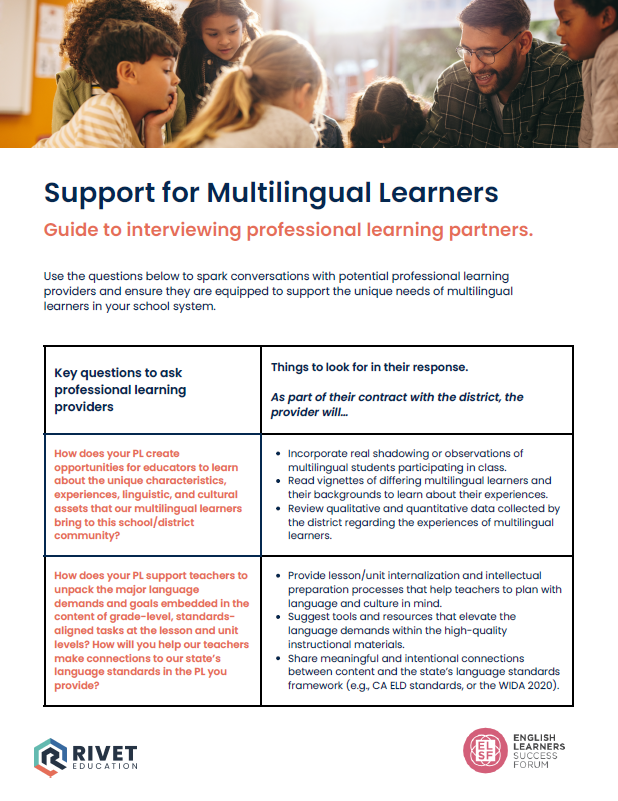In the United States, about 65% of all teachers have at least one multilingual learner in their class. Yet, more than half of teachers say that their professional learning opportunities provided limited training on supporting multilingual learners while using required curriculum materials. This substantial professional learning (PL) gap can only be closed when PL providers rise to meet the demand from districts and teachers for high-quality professional learning that develops educators’ efficacy to serve the fast-growing group of bright minds who are multilingual learners.
What should districts consider when looking for PL partners to actualize their vision for multilingual learner success?
Districts should seek PL partners who integrate the core beliefs in ELSF’s Framework for Designing Professional Learning Inclusive of English Learners:
- Core Belief 1: Student assets are learning resources. PL partners should help educators recognize and leverage the rich linguistic and cultural assets multilingual learners bring to the classroom.
- Core Belief 2: Language and content are interconnected. PL partners should provide training that seamlessly integrates language and content instruction, emphasizing how language development supports content learning and vice versa.
- Core Belief 3: Challenge all students through cognitively demanding tasks. PL partners should model and promote the use of cognitively challenging tasks that are accessible to all learners, including multilingual learners.
- Core Belief 4: Student agency and ownership of ideas are essential for learning. PL partners should encourage instructional strategies that empower multilingual learners to take ownership of their learning and express their ideas confidently.
What should PL partners provide to ensure that multilingual learners can access the quality curriculum and instruction they deserve?
To ensure that their professional learning meets the needs of all students, PL partners must go beyond developing educator knowledge and skill in core content areas. They need to deeply integrate the following elements crucial for serving multilingual learners:
- Knowledge of multilingual learners: Understanding the unique characteristics, experiences, backgrounds, and assets that multilingual learners bring to the classroom. This includes recognizing the diversity within multilingual learner populations and avoiding generalizations.
- Knowledge of language pedagogy: Knowing how to promote language development and scaffold learning in ways that attend to how language works in content and thinking. This includes providing explicit language instruction, using a variety of scaffolds, and creating opportunities for authentic language use.
- Instructional practices: Implementing routines and practices that mutually reinforce learning of language, content, and disciplinary practices. This includes incorporating culturally and linguistically sustaining practices that affirm students’ identities and build on their existing knowledge.
- Self-awareness: Encouraging reflection on educators’ own capabilities, biases, and beliefs about language, culture, and teaching. This includes helping educators identify and address their own implicit biases and develop culturally responsive teaching practices.
PL partners need to be able to provide professional learning that incorporates activities, experiences, vignettes, exemplars, data/evidence, and application tasks that engage teachers in incorporating such new knowledge and pedagogy into their practice.
Use the questions below to spark conversations with potential PL providers and ensure they are equipped to support the unique needs of multilingual learners in your district.
| Key questions to ask PL providers | Things to look for in their response. As part of their contract with the district, the provider will… |
| How does your PL create opportunities for educators to learn about the unique characteristics, experiences, linguistic, and cultural assets that our multilingual learners bring to this school/district community? | Incorporate real shadowing or observations of multilingual students participating in class. Read vignettes of differing multilingual learners and their backgrounds to learn about their experiences.Review qualitative and quantitative data collected by the district regarding the experiences of multilingual learners. |
| How does your PL support teachers to unpack the major language demands and goals embedded in the content of grade-level, standards-aligned tasks at the lesson and unit levels? How will you help our teachers make connections to our state’s language standards in the PL you provide? | Provide lesson/unit internalization and intellectual preparation processes that help teachers to plan with language and culture in mind. Suggest tools and resources that elevate the language demands within the high-quality instructional materials.Share meaningful and intentional connections between content and the state’s language standards framework (e.g., CA ELD standards, or the WIDA 2020). |
| How does your PL show and model for teachers how to amplify language and content learning without simplifying or reducing the rigor of grade-level, standards-aligned tasks? | Identify areas in the instructional materials that can be bolstered to provide stronger supports for students’ conversations that build up substantive disciplinary ideas and language.Review instructional materials for an explicit focus on developing language connected to the key disciplinary practices such as argumentation or mathematical reasoning.Engage in a rehearsal of a lesson and reflect on how the lesson structure and scaffolding routines supported students’ simultaneous learning of content, disciplinary practices, and academic uses of language.Support teacher teams to enhance and adapt instructional materials to fortify language supports during group activities. |
| How does your PL help bridge the work of content and ELD/ESOL professionals and cultivate cross-functional collaboration and teaming? | Provide examples of collaborative tasks that bring English language development professionals together with content teachers to plan implementation using instructional materials. Offer structured PL activities specific to the roles and responsibilities of English language development and content professionals. |
| What multilingual learner-specific data/language-focused data will be used in your PL to support educators in making evidence-based instructional decisions? | Provide PL that includes reviewing writing samples or oral language transcripts with their peers and analyzing work using a protocol that addresses the quality of the interaction.Select and modify (where needed) assessments that provide educators with multiple sources of student evidence (e.g., transcripts of student-to-student conversations). |
| How does your PL support alignment and coherence between the implementation of high-quality core instructional materials with: our district’s dual language program? our district’s ELD blockour district’s Tier 2 instruction? | Develop an understanding of the district’s dual language program model to inform the sequencing and contents of PL activities. Identify gaps in alignment between dual language or English language development instructional materials and provide ways to improve coherence. Support teachers to make evidence-based decisions for small-group instruction and interviews that are multilingual learner-specific and language-focused. |
Want a printable version of these questions? Download the PDF interview guide.

For a deeper dive into creating and implementing effective professional learning that incorporates multilingual learner assets and supports, explore the English Learner Success Forum’s free Professional Learning Framework.





